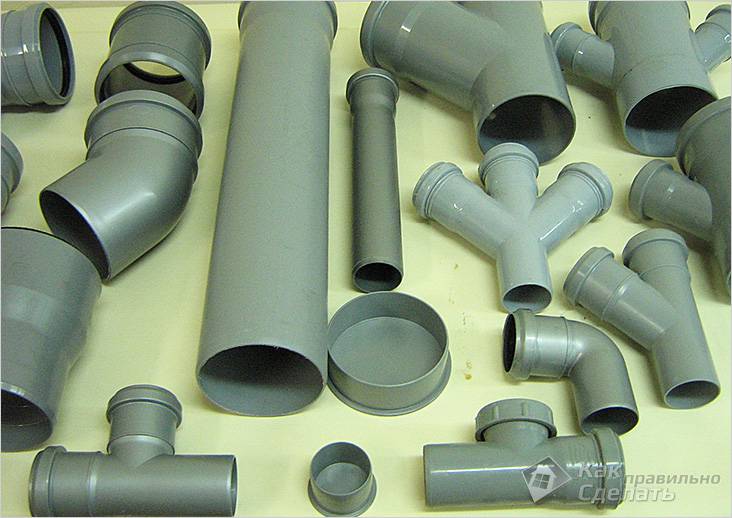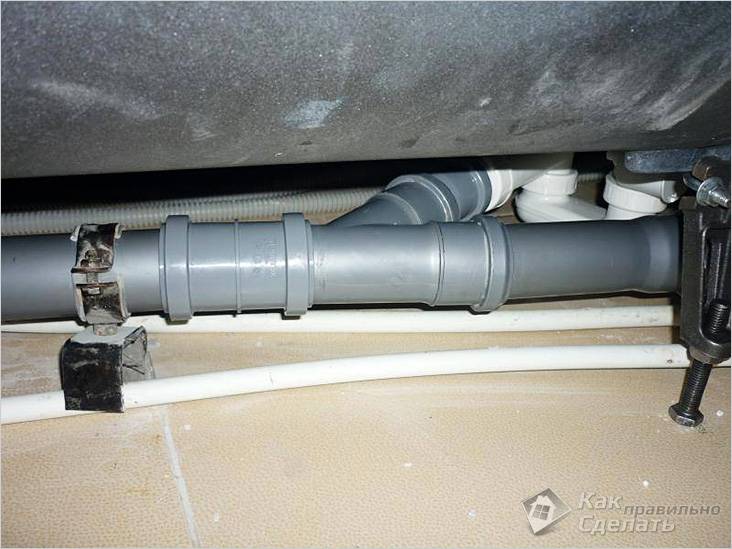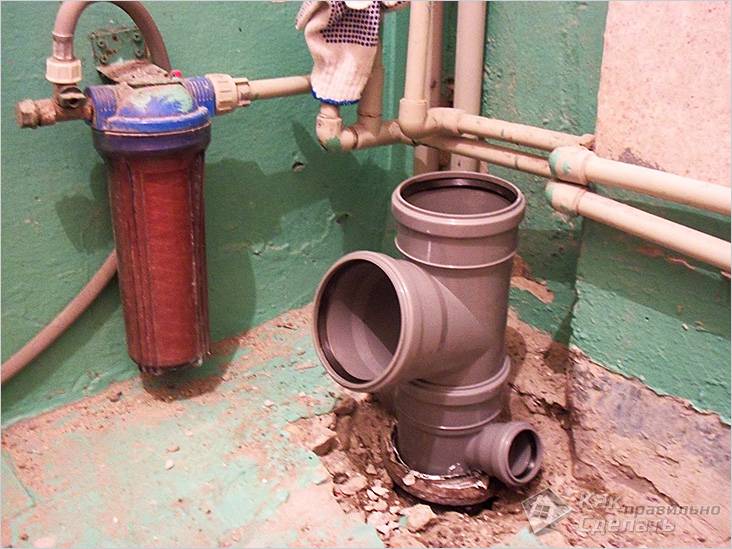What diameter is the sewer pipe in the apartment. Sewerage scheme in the apartment - wiring device for examples
1.
2.
3.
4.
5.
6.
For the installation of a sewer system, a sewage scheme in the apartment is required, which involves the arrangement of a pressure-free structure. In it, through an inclined pipeline, sewage and sewage move towards the sewer riser. The lowest point of waste water discharge in the apartment is considered to be the tee of the building's riser.
In residential buildings, built three dozen years ago, a bathroom and a toilet are located next to the kitchen. With this version of the sewer system, drains are collected, starting from the kitchen, then they pass through the toilet and bathroom and eventually go to the common house riser. Due to the fact that its upper part goes to the roof, the entire sewage system has good ventilation.
How is the sewage system in an apartment building
Wiring of sewage is made in the apartment by means of pipes that are laid with a certain uniform slope and thereby ensure uninterrupted movement of drains. In the case of non-compliance with the required slope, blockages often form in the place of bends of the pipeline. When the pipe diameter is 40-50 millimeters, the optimal slope angle should be 3%, which means 3 centimeters per meter, and with a diameter of 85-100 millimeters - 2%. See also: "".It is with these slopes of the sewer pipeline that high-quality self-cleaning of its internal surfaces occurs. In addition to the slope angle, the degree of filling of pipes with liquid is of great importance for the effective operation of the sewage system. With an excessive slope, the speed of movement of wastewater increases and at the same time occupancy decreases. In turn, reducing the angle leads to the opposite effect. In both cases, the result of self-cleaning deteriorates.
That is why the sewerage scheme in the apartment provides for only two ways of laying the network:
- at a slope of 2-3%;
- strictly upright.

Applied vertical wiring sewage in the apartment when the optimal slope is not able to ensure the output pipes to the height of the plumbing fixture.
DIY sewer wiring
Currently, due to the presence of a large number of plumbing in apartments, the option of equipping a branched sewer system in which each individual branch is laid with an optimal slope is relevant. In new buildings internal sewer connected to the riser, using the inset crosses having three branches. In this case, the diameter of two branches is 50 millimeters, and the third - 100 millimeters.Standard wiring of sewers in an apartment with your own hands is performed as follows:
- a toilet bowl is connected to the main branch of the pipeline with a diameter of 100 millimeters;
- to the first of the main highways (its diameter is 50 millimeters), devices located in the toilet and the bathroom are connected - this is a bath, shower, washing machine, washbasin;
- kitchen plumbing is connected to the second main branch with a diameter of 50 millimeters, and more precisely - a dishwasher and a sink.
Connection diagram for plumbing fixtures
The height at which each of the plumbing fixtures should be located primarily depends on how far away it will be from the main riser.Since the pipes are bred with a uniform slope up, the farther the plumbing is from the riser, the higher the drain should be raised relative to the entry point.
In the diagram reflecting the sewage system in the apartment, you can see two devices that do not need to lift the drain above the floor - this is a dishwasher and washing machine. They have built-in centrifugal pumps that remove waste water under pressure. The connection points of these devices to the sewer system can even be located above the floor covering on which they are installed.
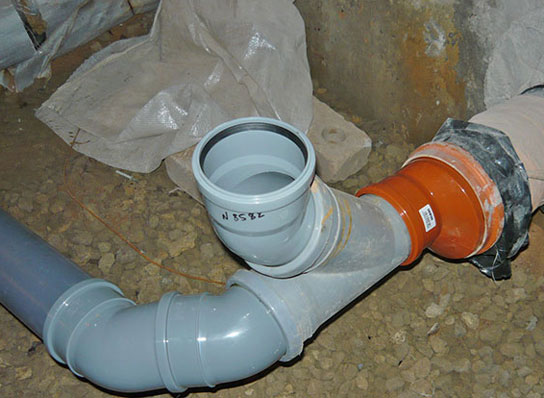
For drainage to be effective in the apartment, you need to know how to properly make the sewers in the apartment and connect plumbing fixtures. For example, you need to connect the kitchen sink and sinks at a height of 50-60 centimeters from the floor surface, while the plumbing does not need to be lifted, since the drains in it are located at a distance of 70-80 centimeters from the plane on which they are installed.
Types of sewer pipes
The assortment of pipes for laying a sewer network is huge, but the following types of polymer products are most often used:- polyethylene;
- polypropylene (read: "");
- polyvinyl chloride.
Features of the device of sewer pipes
The sewage device in the apartment using polymer pipes is simple. Easy assembly provides their special design. Each section of such pipes has a length of 30 centimeters to three meters, while on the one hand there is a sleeve with a rubber sealing ring, and on the other there is a chamfer (read also: ""). All connecting elements are also equipped on one side with a rubber ring coupling. When laying the sewer branch, they take a piece of the pipe, cut it to size, place its smooth side in the coupling of the second segment or fitting.In this case, the pipe is inserted until it stops and then about 10-15 millimeters is pushed back. As a result, a damper gap is formed at the junction to compensate for the thermal expansion of the product.

When wiring the sewer system, it is advisable not to make turns at right angles. Experts advise instead of using one corner fitting 900 to use two of 1350 each, which will significantly reduce the possibility of clogging and will facilitate the unimpeded movement of drains.
Purpose of a water lock in sewer system
Drains and sewage have an unpleasant odor, but they are absent in the apartment, due to the presence of water locks in plumbing fixtures. They are a water plug resulting from the difference of two pipes relative to the height. There is always water in the pipe, completely overlapping it in cross section, even when plumbing is not used. This water barrier prevents sewer gases from entering pipes into the room. After draining, the previous water plug is replaced by a new one.To connect kitchen sinks, showers, bathtubs and sinks to the sewer system, siphons are used, which have dual functions:
- water seal;
- a connecting element between the pipe and the plumbing fixture.
The solution to the question of how to make a sewer in an apartment belongs to an important stage in the preparation for repair work. But for this you need to have a clear idea of \u200b\u200bhow the sewer system functions during its operation.
The sewage system in the apartment is a pressureless system in which the drains move towards the riser due to the inclination of the pipes. The lowest point of the apartment sewerage is the entry tee into the common house riser.
In most houses that were built about 30 years ago, a bathroom and bath were located next to the kitchen. With such a system, all sewage water is collected in a single system, starting from the kitchen, then passes through the bathroom and toilet, and finally merges into a common riser. Thanks to the exit of the upper part of the riser to the roof, the entire system is provided with good ventilation.
Sewer pipes are laid with a uniform slope, which contributes to the uninterrupted flow of drains. If the specified angle of inclination of the pipes is violated, blockages may form at the bends.
The optimal slope of pipes with a diameter of 40-50 mm is 3%, that is, 3 cm per meter of sewer pipe, 85-100 mm - 2%.

It is with these slope parameters that the effect of self-cleaning of pipes is most fully manifested. This effect consists in combining a certain speed of movement of wastewater and the required degree of filling of pipes, at which the waste is washed out without stagnating in the pipes. With an increase in the angle of inclination, the speed of the runoff will increase, and the filling will decrease, a decrease in the angle will cause the opposite effect. In both cases, the self-cleaning process will deteriorate.
|
|
That is why the laying of sewage in the apartment is carried out in only two ways:
- under a slope of 2-3%,
- vertically.
Vertical wiring is used in cases where the optimal slope does not provide the conclusion of the pipe to the required height of the plumbing fixture.
How to sewer in an apartment
Due to the presence of many plumbing fixtures in modern apartments, a branched sewage system is currently relevant, each branch of which is laid with an optimal slope.
Not all plumbing fixtures need to be connected to the sewer. Such devices as a heated towel rail and a water heater are connected only to the water supply system, since they do not form drains.
As a rule, in modern apartments, the internal sewage system is connected to the riser by inserting a cross with three branches into it. The diameter of two branches is 50 mm, and the third is 100 mm.
 Inserting additional crosspieces into the sewer is not possible, since the location of additional entry points above the main crosspiece will require too high a plumbing fixture, and under it it will affect the territory of neighbors.
Inserting additional crosspieces into the sewer is not possible, since the location of additional entry points above the main crosspiece will require too high a plumbing fixture, and under it it will affect the territory of neighbors.
The standard wiring of the sewage system in the apartment is as follows:
- a toilet and a bidet are connected to the main highway with a diameter of 100 mm;
- to the first main highway with a diameter of 50 mm connect all other devices of the toilet and bath - shower, bathtub, sinks, washing machine;
- to the second main main pipe with a diameter of 50 mm are connected kitchen plumbing fixtures - a sink and a dishwasher.
Features of connecting plumbing fixtures
The height at which the plumbing fixture should be located depends on its distance from the main riser. Since all pipes are led with a uniform slope upwards, the farther from the riser the device is located, the higher the drain should be raised relative to the entry point.
In the sewer system, there are two devices that do not need to be raised above the floor to drain:
- washer,
- dishwasher.
They are equipped centrifugal pumpsthat remove waste water with force, and not under the action of gravity. The connection points of these devices to the sewer system can be located even higher than the plane on which these devices stand. Therefore dishwasher and washing machine can be installed at the farthest and highest points of the sewer system.
Connection to the sewer system of the sink and kitchen sink can be carried out at a height of 50-60 cm from the floor surface. At the same time, the devices themselves are not required to be lifted, since the drains from these devices can be at a distance of 70-80 cm from the plane on which the device is installed.
Varieties of sewer pipes and features of their laying
 For the installation of a sewer system in an apartment, most often, three types of polymer pipes are used:
For the installation of a sewer system in an apartment, most often, three types of polymer pipes are used:
- polypropylene
- polyethylene
- polyvinyl chloride.
The fundamental difference between them when applied in the conditions of intra-apartment wiring is not traced. Pipes - PVC and polypropylene - can be equipped with additional sound insulation. Cast iron sewer pipes are practically not used.
Sewerage repair in the apartment , carried out using polymer pipes, as simplified as possible. Light assembly technology provides the special design of these pipes. Each segment, and its length can range from 300 mm to 3 m, is equipped on one side with a coupling with a rubber o-ring. There is a chamfer at the second end of the pipe. All fittings also have a rubber ring coupling at one end.
To lay the sewer branch, take a piece of pipe, if necessary, cut it into size, insert the smooth side into the coupling of the next segment or connecting fitting.
One small but important rule should be observed.
The pipe is first inserted into the coupling until it stops, and then it is pushed back a little (10-15 mm).
Thus, a damper gap will be formed in the joint, which will compensate for the thermal expansion of the pipe. When exposed hot water a polymer pipe with a significant coefficient of linear expansion will increase by several millimeters. If the pipe has nowhere to lengthen, then it will skew, which will lead to a violation of the tightness of the coverage of the segment with a sealing ring. The connection will leak.
When laying the sewer network, it is better to avoid turns at right angles.
It is advisable to use two instead of one corner fitting 90 0 - 135 each 0 is:
- significantly increase the throughput of sewer pipes,
- reduce the risk of clogging.
The role of the water trap in the sewer system
Sewer water has an unpleasant odor. However, in the apartment we don’t feel them thanks to a simple but very important device - a water seal.
A water lock is a water plug that forms when two pipes drop in height. At the same time, a certain amount of water is constantly in the pipe, completely overlapping it in cross section, even when sewerage is not used. Sewer gases do not penetrate pipes into the room precisely because of this water barrier. At the time of discharge, the water plug is replaced with a new one.
If you do not use the bathroom for a long time, then an unpleasant odor may appear in the rooms. This is due to the evaporation of the liquid, which leads to the drying of the water seal.

To fix the problem, just turn on the taps for a few minutes and drain the toilet.
To prevent the drying of the hydraulic seal, you can use a little trick.
Before leaving the apartment, pour a small amount of vegetable oil into the drain holes. The oil forms a film that protects the liquid from evaporation.
The toilet and bidet initially have water locks in their design.
Kitchen sinks, sinks, bathtubs, showers are connected to the system using siphons, which play a dual role:
- a connecting element between the device and the pipe,
- water seal.
Restoring sewage in a house is an important part of repairing intra-apartment work. And therefore, it is necessary to clearly understand the principle of the sewer system, which will avoid gross errors during the installation of pipes and plumbing fixtures.
All household wastewater from numerous plumbing fixtures of an apartment is discharged through sewer pipes. The developers take care of their installation, but homeowners have to deal with the repair and replacement of utilities. Sometimes in a new building it is required to lay sewage from scratch. Installation work can be entrusted to plumbers, but if there is free time and a desire to save money, then the sewerage in the apartment is installed by yourself with your own hands. The main thing is to know how to make piping and connect plumbing.
The first step is planning

Before installing the pipes and installing the plumbing, it is necessary to plan the sewer system. The scheme includes the following elements:
- location of plumbing fixtures: toilet , sink , shower stall , bath , dishwasher bidet;
- pipe length and diameter;
- distance from walls to plumbing and pipes;
- riser location;
- diameter of siphons for connecting the sink and bath;
- number of connecting elements (fittings);
- location of audit points.
If it is not planned to connect new points, then you can not change the existing wiring of the sewage system. This will simplify the calculation of the required material. The length of all pipes is measured in place, if they pass through the wall, then the size of each section will be required.

The diameter of the sewer pipes is not chosen arbitrarily, there are recommendations for their size:
- section for the riser - 110 mm;
- for the toilet - 110 mm;
- for a bathtub, a sink and other devices - 50 mm.
To connect some devices, a 32 mm pipe is sometimes used.
The slope also does not have to be chosen independently, pipes with a diameter of up to 50 mm are located at an angle of 3º, and 110 mm - 2º. This means that in a 1 meter section, the slope changes by 3 and 2 cm, respectively. The correct location of the line ensures the movement of water in the gravity system.
Material selection
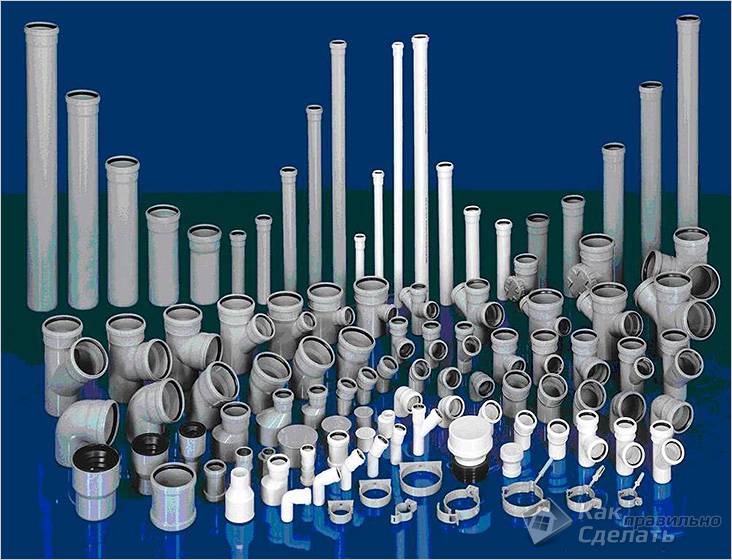
- smooth surface on which deposits do not accumulate;
- strength, corrosion resistance;
- a light weight;
- durability;
- installation does not require welding.

To connect the pipes, special elements are required: bends, tees, transitions from metal, cuffs. It is better to purchase all the necessary material from one manufacturer, this guarantees the accuracy of matching all diameters. Sealing joints requires silicone grease, it is also bought in advance. So, for work we will need:
- plastic pipes with a diameter of 50 and 110 mm;
- fitting;
- sealing cuffs;
- plastic clamps selected by the cross-section of the pipes;
- revision hatch, which is installed on a common riser;
- silicone sealant.
Instruments:
- hammer drill;
- bulgarian;
- hammer;
- hacksaw;
- chisel;
- adjustable spanners of various sizes.

Sewer replacement begins with a riser. This is the most difficult part, drains from neighboring apartments pass through it, so at the time of replacing the pipe, you need to ask your neighbors not to use the sewage system for some time. Dismantling is as follows:
- Access to the docking point of the riser with the neighboring section is opened. This may require breaking up part of the overlap.
- Part of the cast-iron pipe is cut out by a grinder. If it is not possible to cut through completely, then it can be broken with a hammer. The work must be carried out carefully, as a cracked piece of pipe may remain inside and block the entire pipe.
- In the lower part of the riser, a tee is installed near the floor. The straight plastic pipe selected for the riser is connected at the top with the remainder of the cast iron pipe using a transition sleeve. Fastening with a tee is carried out by a bell. The joint tightness is ensured by a rubber ring and silicone sealant.
- The pipe is attached to the wall with clamps. In the area of \u200b\u200bthe sockets, the pipe is fixed rigidly, in other places the fixation is floating.
After installing the riser, proceed to the wiring.
Sewerage system installation
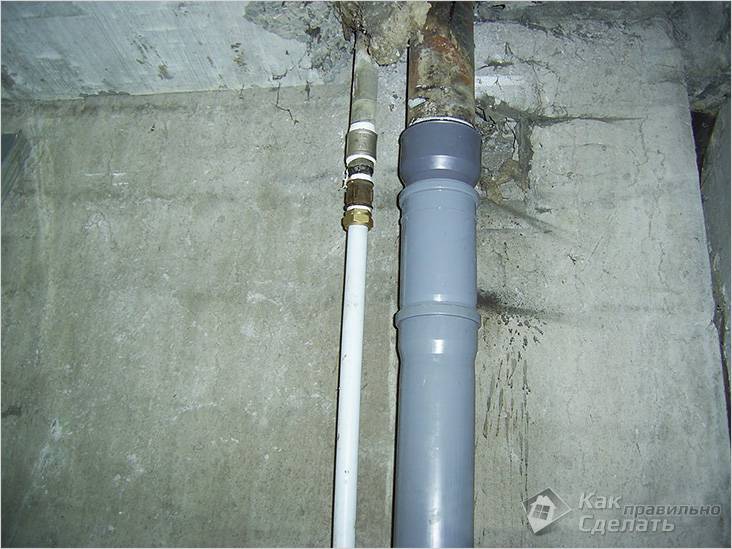
All plumbing fixtures are disconnected from the pipes that must be removed. After removing the old system, the location of the new trunk is marked. When installing the pipeline, it is preferable to direct sections, bends and turns that provoke blockages, there should be a minimum amount. Proper installation of the sewage system with a small number of connections and a consistent angle of inclination ensures self-cleaning of the system. With each flush, the stream carries away the remainder of the previous stream.

Organize markup pipe slope it is possible with the help of a line on the wall or a cord fixed at the highest and lowest point of the sewer system. According to this marking, the installation locations of the fasteners are determined, for pipes Ø 50 mm, clamps are placed after 50 cm. To relieve stress in the pipes, two types of fastening must be combined:
- rigid - the pipe is fixed with a clamp with a rubber gasket;
- floating - fasteners allow the pipe to move, performed without a rubber insert.

Before installing the pipes, they must be chamfered and the edges cleaned so that there are no burrs. The inside of the pipe and fitting must be clean and dry. When making the connection, the end of the pipe is inserted into the socket until it is snug. To enhance the tightness, silicone grease is applied to the rubber ring. The bells should be located with the flow of water. During the operation of the sewage system, temperature deformation of the plastic occurs. So that the seam does not lose tightness when expanding the material, a gap of 1 cm is left. This is done as follows: the pipe is inserted into the socket to the stop, then a mark of 10 mm is made and the part is pulled back to this mark.
In order not to have to redo the finished system, it is worth making a trial installation without tight connections. After verifying that the installation is correct and that all parts are present, you can complete the final assembly.
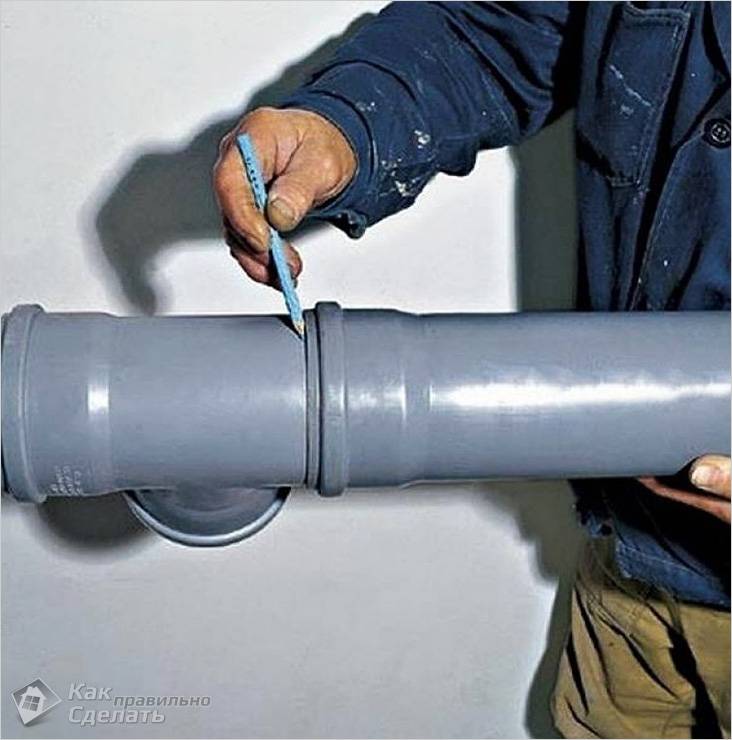
- Only straight plastic pipes can be cut. Most often, at home, the cut is performed with a hacksaw for metal, always at an angle of 90º.
- If necessary, make a turn, it is better to use two bends of 45º. They do not radically break the moving drains, so they clog less often.
- The toilet joins the system first, then the rest of the plumbing fixtures.
- In complex areas, a segment is called a revision. It has a hole closed with a rubber cover through which you can inspect the inner surface of the pipe.
- Part of the plumbing is connected to the sewer directly, but there are appliances that require siphon installation . This is a device with a bend in the form of a knee, inside of which there is always water for a water seal. The siphon prevents unpleasant odors from the sewer system from spreading indoors.
- Wiring of the sewage system is carried out not only along the walls, but also in the gate. Before being placed on the wall, the pipes are wrapped with soft material to reduce noise. So that cement does not get into the joints, they are sealed with tape. In the gates, the pipes are fixed in a floating manner.
- The ends of the horizontal bends are closed with plugs.

After installation, it is necessary to check the tightness of the assembled system in all sections of the wiring in the apartment and at the junction with the riser. The reliability of the docking of a new riser with a neighboring pipe is checked after the drain in the upper apartment. To check, water is collected in the bathroom, and then a cork is removed, both faucets in the kitchen open, the water in the toilet drains. The reliability of the joints is easy to evaluate - they should all be dry.
Video
This video shows how to replace a flat iron ducting sewer in Stalin with plastic:
A photo
